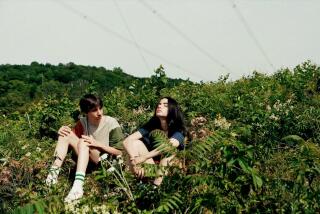Truffaut’s tender care for a ‘Child’
- Share via
Forty years ago, Laura Truffaut and her younger sister, Eva, spent an idyllic summer in the French countryside with their father, the groundbreaking New Wave director Francois Truffaut (“The 400 Blows,” “Jules and Jim”).
The late filmmaker was on location working on one of his most lyrically haunting movies, “The Wild Child.” A beautiful new print of the award-winning film, which was released in America in 1970, arrives Friday at the Nuart Theatre in West Los Angeles for a one-week engagement.
“I was 10,” recalls Laura Truffaut, who has lived with her husband and children in Berkeley for the last two decades. “My dad noticed I was bored staying in a house. So he would bring me to the set. I was present for a number of scenes. I was very lucky I spent so much time on the set. There was so much talent.”
“The Wild Child” is inspired by the early-19th century journal of Dr. Jean Itard revolving around his work with the Wild Boy of Aveyron.
Jean-Pierre Cargol plays the title character, a young boy who is found in the forest near Aveyron, France, in the late 18th century.
Mystery child
The wild child had been living like an animal -- unable to communicate or even walk like a human. Naked and filthy, he had been scrounging for food and water in the forest. The boy, eventually called Victor, was placed under the care of Dr. Itard (Truffaut, in his first film role), who attempted to civilize and educate the child. Both Truffaut siblings also appear as extras in the film.
“Wild Child” also marked the first collaboration between Truffaut and cinematographer Nestor Almendros, who supplied the evocative, documentary-style black-and-white photography. Almendros worked on several of Truffaut’s subsequent films, including “The Story of Adele H” and “The Last Metro.”
“I think the film has aged really well,” says Laura Truffaut, who recalls her father’s assistant combing schools in France, looking for the perfect young boy to play Victor.
“I remember my father showing me some photographs of possibilities for the child. And Jean-Pierre looked very different because he looked ethnically different. He is a Gypsy. He had an uncle who was a very well known classical guitar player. He’s so moving in the film, and it was hard because he doesn’t have any dialogue.”
Truffaut took on the role of the doctor not only because it would be easier to direct the 12-year-old Cargol but also, says his daughter, “because he felt it wasn’t a great role for a professional actor.”
Nurturing instinct
“He was much more interested in the child than Dr. Itard,” Laura Truffaut adds. “I think he worried that unconsciously a professional actor would feel slighted or neglected by him. He must have been thinking of movies where he felt the adult upstaged the child in a situation like that. He couldn’t imagine who would enjoy the experience of really always being second fiddle, in a way.”
Her father told her that he never considered it a real acting experience. “I suspect that, years later, when Steven Spielberg offered him a role in ‘Close Encounters of the Third Kind,’ he wanted to have an experience of being an actor in somebody else’s film.”
Despite Truffaut’s own reservations about his performance, he gives a tender, often delicate turn as the young doctor trying desperately to civilize Victor. The performance caused his friend Alfred Hitchcock to send him a funny telegraph, asking Truffaut for the autograph of the actor who played the doctor.
“The Wild Child” marked Truffaut’s second feature dealing with the turbulent lives of children.
The director, who dropped out of school at age 14, had a difficult childhood, which he explored in his seminal 1959 feature film debut, “The 400 Blows,” starring Jean-Pierre Leaud as his alter-ego, Antoine Doinel. “The Wild Child” is dedicated to Leaud.
“I think the movie felt very personal to my dad,” Laura Truffaut says of “The Wild Child.” “It had to do with childhood, his youth. The film is not about fatherly love or a father figure, but just to show interest is a form of love, to show involvement and preoccupation in a child’s future is a form of love.
“It was something that was very personal.”
--
More to Read
Only good movies
Get the Indie Focus newsletter, Mark Olsen's weekly guide to the world of cinema.
You may occasionally receive promotional content from the Los Angeles Times.










